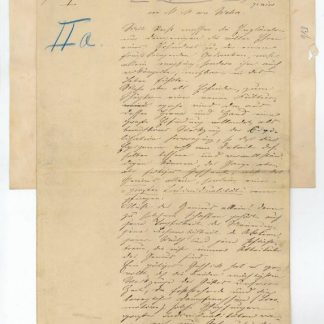Ce sont les noms des présidents et conseillers de Parlement étant l'an courrant mil CCCC soixante et trois.
Folio (ca. 230 x 410 mm). French manuscript on a single leaf of vellum.
€ 3,500.00
A list of the 103 conseillers and 15 huissiers (ushers of justice) of the Parlement of Paris in the year 1463. The list in two columns begins with the first president, Mathieu de Nanterre (1461-65), and his three deputies Yves de Stepeaux, Robert de Thiboust, and Jean de Boulenger, who would serve as first president from 1471 to 1481, followed by the four presidents of the Chambre des Enquêtes: Montdider, Le Sellier, Jean de la Réauté, and Jean Henry. Among the conseillers are members of important Parisian families of magistrates such as Burdelot, de Longueil, and de Montigny. Three greffiers (clerks), including the author of the manuscript, Jean Cheneteau, and four notaries complete the list. The huissiers follow in two columns in the lower margin, below Jean Cheneteau's signature.
First established by Louis IX of France on the Île de la cité in 1250 and regularized in a 1278 ordinance of Philip III, the Parlement de Paris would become one of the central legal and political institutions of the Ancien Régime. Juridically, the Parlement primarily functioned as an appellate court and court of cassation. Its political power arose from the parliamentary duty of enregistering all royal ordinances, letters patent, and edicts, which slowly evolved into a "droit de remonstrance" (right to remonstrate), as the Parlement could refuse to enregister royal legislation it deemed contrary to the interests of the people or the fundamental laws of the kingdom. The most significant political acts in its almost 540-year history were the opposition to the Jesuits that led to their expulsion from France in 1594, the revocation of the testament of Louis XIII in 1643, the Parlementary Fronde (1648/49), and the revocation of the testament of Louis XIV in 1715. While Louis XIV effectively weakened the political power of the Parlement between 1673 and 1715 by curtailing the Droit de remonstrance, the centralization of power and the disempowerment of the old nobility that marked French absolutism were strongly connected with the rise of the so-called "noblesse de robe", a class of educated magistrates, advocates, and merchants controlling the Parlement and other legal institutions. The most famous name connected both with the Parlement and the administration of Louis XIV is certainly Nicolas Fouquet, but important families such as the de Harlay, de Longueil (already present on this list), and Le Peletier might also be mentioned.
From the collection of Jean-Baptiste Gaignare, baron de Joursanvault (1748-92). Acquired in 1838 by Arthur Nouail de La Villegille (1803-82), president of the Société des antiquaires de France.
Minor tears and creases. With a large water spot affecting the text and a small stain affecting the title.






